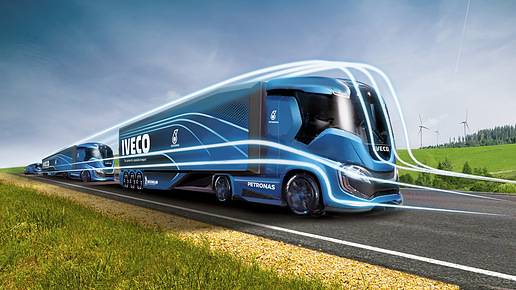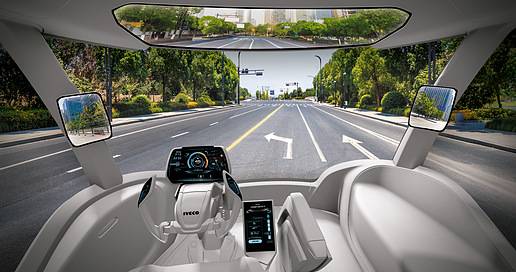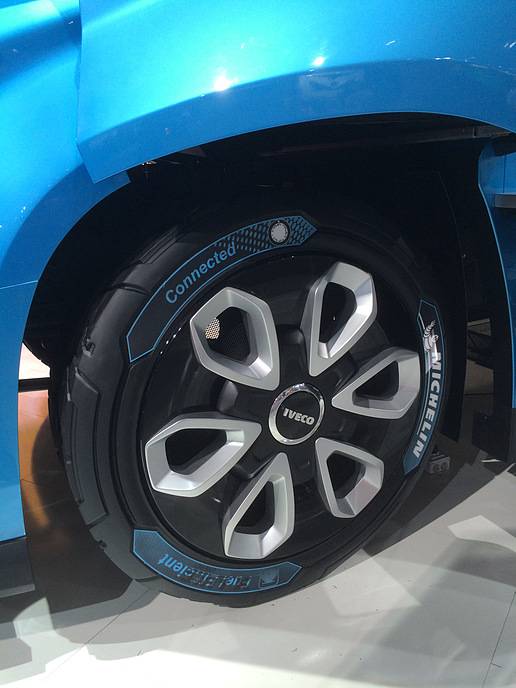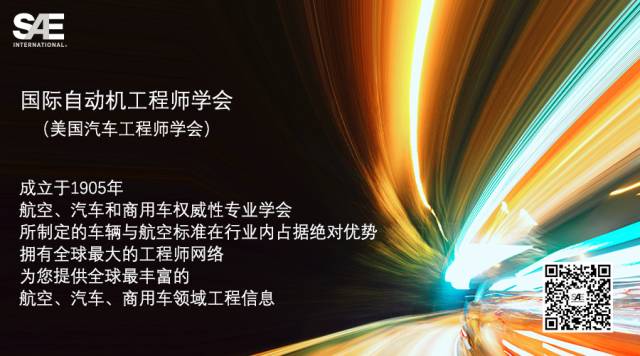 IAA商用车展上,依维柯ZTruck概念卡车凭借极具未来感的外形和优异的空气动力表现,一亮相便脱颖而出。
IAA商用车展上,依维柯ZTruck概念卡车凭借极具未来感的外形和优异的空气动力表现,一亮相便脱颖而出。 依维柯Z Truck概念卡车采用了整合式拖车和大胆的牵引车几何形状设计,最终实现了高达30%的风阻降幅。这款卡车还有可能在队列模式下取得更优异的空气动力学表现。
依维柯Z Truck概念卡车采用了整合式拖车和大胆的牵引车几何形状设计,最终实现了高达30%的风阻降幅。这款卡车还有可能在队列模式下取得更优异的空气动力学表现。 替代能源在依维柯的可持续交通系统战略中扮演着非常关键的角色。这款长途货车概念车采用了新一代液化天然气发动机,燃料为从经过精制的生物沼气中提取的生物甲烷。
替代能源在依维柯的可持续交通系统战略中扮演着非常关键的角色。这款长途货车概念车采用了新一代液化天然气发动机,燃料为从经过精制的生物沼气中提取的生物甲烷。 这款概念卡车的人机界面经过专门设计,可根据驾驶员的需要,调整信息显示方式,包括“智能”挡风窗上的信息显示。Z Truck概念卡车还可将多摄像头系统捕捉的多角度视图显示在挡风窗的上方区域。
这款概念卡车的人机界面经过专门设计,可根据驾驶员的需要,调整信息显示方式,包括“智能”挡风窗上的信息显示。Z Truck概念卡车还可将多摄像头系统捕捉的多角度视图显示在挡风窗的上方区域。 概念卡车的互联技术已经延伸至米其林(Michelin)提供的超未来感轮胎。这款轮胎的滚动阻力超低,且内置RFID标志,可在整个生命周期内记录轮胎的使用情况。
概念卡车的互联技术已经延伸至米其林(Michelin)提供的超未来感轮胎。这款轮胎的滚动阻力超低,且内置RFID标志,可在整个生命周期内记录轮胎的使用情况。
在最近举行的德国IAA(汉诺威)商用车展上,依维柯(Iveco)带来了一款科技感十足的Z Truck概念卡车。据了解,这款卡车由CNH工业集团(CHN Industrial)的设计中心和创新部门联合设计研发,展示了依维柯眼中的未来卡车概念。无论是以生物甲烷为燃料的新一代液化天然气发动机,还是先进自动驾驶系统、增强空气动力学性能、升级安全表现以及全新驾驶室生活空间均是未来卡车概念中不可或缺的元素。
依维柯声称,这款长途概念卡车将打破所有约束,完全不会对可持续发展交通系统造成任何影响。
“正如我们的Z Truck及其采用的29项专利,依维柯将不懈努力,定义未来卡车的面貌:未来卡车应该可以共享人类维度,且长期稳定满足驾驶员的各种工作和休闲需求。”依维柯品牌总裁Pierre Lahutte表示,“在我们的定义中,长途货车必须满足100%的可持续性,也就是说不能对周围环境造成任何影响,即实现‘零排放’和‘零事故’。”
据了解,Z Truck概念卡车采用了液化天然气动力系统搭配16速变速器的设计,额定功率460hp(约合343 kW),扭矩2000 N·m(约合1475lb·ft)。报道称,ZTruck可节省33%的“油耗”。根据依维柯的数据,这款概念卡车配有两个油箱,总容量1200升(317加仑),每次满充后的续航里程达2220 km(1380 mi)(1380英里),比现行版Stralis NP天然气卡车高60%。
Z Truck概念卡车采用了SAG公司研发的新概念油箱。该油箱采用铝制箱体,并搭配了一种新型多层绝缘技术(Multi Layer Insulation),可保护油箱免受热辐射损害。这种技术让正方形油箱的出现成为可能,也最终帮助工程师充分优化空间利用,实现了双油箱的设计。
此外,Z Truck概念卡车还搭配了一款车载朗肯循环废热回收系统,可重复利用废气热源进行热量回收。
Z Truck的研发还受到了PLI(Petronas Lubricants International)公司的大力支持。这款概念卡车采用了液化天然气搭配PLI低粘度机油的设计,这有助于依维柯实现零排放目标。
Lahutte表示,未来卡车还必须实现零事故的目标,依维柯则将通过一系列主动/预防安全功能及全自动驾驶系统的研发实现这一愿景。依维柯认为,未来这些新兴技术和自动驾驶系统将改变人类驾驶员的角色,将他们变成“车载物流操作员”。
Lahutte还表示,“零压力”和“零时间浪费”也是公司“以驾驶员为中心而设计”的关键目标。在依维柯看来,未来驾驶室应完全摆脱传统的约束,可根据驾驶员的每日活动进行自由配置,比如驾驶、自动驾驶、室内工作或休息等。车辆的座椅、方向盘、油门、刹车及中控台将构成一个完整系统,可独立于驾驶室进行控制。
车辆座椅和可伸缩方向盘可相互配合,便利驾驶员的需求:当方向盘伸出时,座椅将向后回撤,从而为驾驶员提供一个舒适的位置。而驾驶室的部分侧墙、顶部和地板将形成一个独立滑动空间,可将内部空间增加50厘米。
此外,车辆滑门还可旋转滑开,可伸缩平台伸出,接着5阶台阶以平行于车辆的方向滑出,从而为驾驶员提供与房屋类似的台阶设计,方便人员出入。
这款概念卡车的人机界面经过专门设计,可根据驾驶员的需要,调整信息显示方式。卡车提供的信息将显示在“智能”挡风窗上,而且可以根据驾驶员的实时需求进行调整变化。此外,Z Truck概念卡车的挡风窗上方区域还可以显示车辆多摄像头系统捕捉的多角度视图,从而协助驾驶员全面了解车辆周围的情况。
“我们将面对一场源于环保、经济和安全考虑的革命。”Lahutte表示,“依维柯一直视支持可持续发展、降低总拥有成本(TCO)以及与我们的客户建立商业合作伙伴关系为核心价值观。我们一直致力于通过生物天然气等可替代能源,持续降低依维柯车辆对环境的影响,并始终将驾驶员和消费者放在我们技术研发的中心位置。”
此外,概念卡车的互联技术还延伸至米其林提供的超未来感轮胎。据了解,米其林XLine Energy是第一款被授予AAA级滚动阻力表现的轮胎,可帮助长途货车节省燃料(1L/100km)。每一个X Line Energy轮胎均内置RFID标志。驾驶员可凭借该标志追踪该轮胎在整个生命周期内的使用情况,并实时查询类型、尺寸、型号、磨损、性能或胎温等信息。此外,配合轮毂上的传感器,胎压监测系统还可以提供胎压数据。这些信息中的部分或所有均可以在有必要时显示在驾驶室内,为驾驶员提供警示。
依维柯Z Truck概念卡车采用了整合式拖车和大胆的牵引车几何形状设计,在空气动力学性能方面取得了大幅提升。依维柯表示,这款概念卡车的风阻系数最高可降低30%,且在队列配置下还有可能实现更高提升。
Designed in collaboration by CNH Industrial’s Design Center and Innovation department, the Iveco Z Truck concept that debuted at the IAA Commercial Vehicles show in Hanover, Germany, is the company’s take on what future trucks may look like. This vision includes alternative energy—a new-generation LNG (liquefied natural gas) engine running on bio-methane derived from refined biogas—automated driving, enhanced aerodynamics, improved safety and the creation of a new living space in the cab.
The long-haul concept truck breaks away from every constraint, the company claims, to be a zero-impact vehicle for a totally sustainable transport system.
“With Iveco Z Truck and its 29 patents, we are defining where our efforts could lead us in the future: a vehicle with a human dimension, designed to accommodate comfortably and safely the work and leisure activities of the driver, adapting each time to his needs,” said Pierre Lahutte, Iveco Brand President. “We are defining a future of long-haul freight transport that is totally sustainable—a vehicle that has zero impact on its environment, with zero emissions and zero accidents.”
The LNG powertrain has rated power of 460 hp (343 kW), torque at 2000 N·m (1475 lb·ft), and a transmission with 16 gears automated with powershift in the upper gears. The Z Truck reportedly uses up to 33% less fuel. Two tanks with a capacity of 1200 L (317 gal) result in a range of 2220 km (1380 mi)—60% greater compared to the current Stralis NP natural-gas model, according to Iveco.
The truck adopts a new concept tank developed with SAG. It is made of aluminum insulated with a new Multi Layer Insulation, a reflective foil that protects from heat radiation. The technology allows for a squared shape, making it possible to optimize the use of space and accommodate two tanks with a single recharge.
An onboard Rankine-cycle waste heat recovery system exploits exhaust gas as a heat source to recover energy.
Petronas Lubricants International supported development of the Z Truck. LNG used in conjunction with Petronas Urania low-viscosity engine oils contributes to Iveco’s zero-emissions target.
Zero accidents are the vision for this concept truck through the deployment of active and preventive safety technologies up to full automated driving technologies, according to Lahutte. Iveco sees a future in which these new technologies and autonomous driving will change the role of the driver, who they say will become an “onboard logistics operator.”
Lahutte also shared that zero stress and zero waste of time is the goal of the driver-centered design where the cab is freed from traditional constraints and can be totally reconfigured according to the various activities of the day (driving, automated driving, office working, resting). The seat, steering wheel system, pedals and controls console form a self-contained unit that is suspended independently from the cab.
The seat and retractable steering wheel combine two systems that move together in a double arch rotation: while the steering wheel moves forward, the seat moves back to provide a comfortable position for the driver. Parts of the side wall, the pavilion and the floor are integrated to form a self-supporting box-sliding structure, adding 50 cm (20 in) of interior length.
A sliding door opens and moves away with a rototranslating movement, enabling a retractable platform and 5-step stairs to slide out parallel to the vehicle. This provides full ergonomic access to the cab similar to home stairs.
The HMI (human-machine interface) is designed to adapt the way it provides information to the driver. The information on the truck’s functions is projected on the “smart” windshield as it becomes necessary and changes according to what the driver needs at the time. Views from a multi-camera system are displayed on a wide screen at the top of the windshield, giving the driver full visibility around the vehicle in every driving phase.
“We are facing a revolution triggered by the concern for the environment, the economy, and safety on and around vehicles,” said Lahutte. “With our focus on our values of sustainability, TCO (total cost of ownership), technology and business partnership with our customers, at Iveco we have been working to constantly reduce the impact of our vehicles with alternative fuels such as bio-LNG, and putting the driver and the customer at the center of our technological and design development.”
Connected technology extends to the futuristic tires supplied by Michelin. The Michelin X Line Energy tires are the first range to be awarded the AAA grading in rolling resistance, which saves long-haul convoys up to 1 L of fuel per 100 km. The tires feature RFID embedded tags that can track each tire throughout its life cycle, providing real-time information such as type, size, model name, wear, performance or temperature. Used with Tire Pressure Monitoring System sensors on the rims, they can also provide pressure data. Any or all of this data can be displayed in the cab as necessary to alert the driver.
Anticipated improvement in aerodynamics results from the integration of the trailer and the extreme geometry changes on the tractor. As a result, drag is reduced by up to 30%, according to Iveco, with potential for further improvement in platooning configuration.
Author: Greg Muha,Ryan Gehm
Source: SAE Truck & Off-highway Engineering Magazine
等级
打分
- 2分
- 4分
- 6分
- 8分
- 10分
平均分
